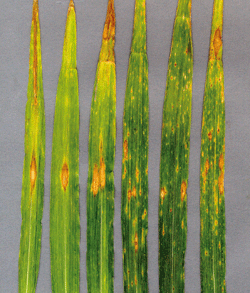Changing climate might change spray programmes

Tan spot and rusts – black stem rust, as well as more familiar brown and yellow rust – could become the key wheat diseases for growers to control as our climate changes, according to Bill Clark, director of Broom’s Barn.
And that would almost certainly mean some major shifts in fungicide timings.
“Our whole system at the moment is geared up to controlling septoria, which is why brown rust caught out some people last season.”
Current fungicide timings were designed during 1980s “wave” [timing] trials, he says. “And they work because they were created for septoria using triazoles. But they don’t work for black stem rust, tan spot or for brown rust. Last year was a taster of that.”
The reason is the much shorter latent periods each of those diseases has, he explains. That shorter period means the month or longer gap between spraying final leaf three at T1 and targeting the flag leaf at T2 can allow disease to become established on leaf two, which cannot be eradicated with the flag-leaf spray. “It means a spray will need to be targeted specifically at leaf two.”
That might be through an additional spray in between T1 and T2 or possibly a rethink in timings of sprays, he suggests. “It will certainly force growers into a three-spray programme, possibly even four or five sprays.”
A timing rethink would mostly surround the latter stages of the programme. The T0 and T1 timings would remain unchanged, but the T2 timing would be brought forward to target leaf two. That could mean spraying as the flag leaf emerges (GS37), although in some years that might not be early enough, Mr Clark says. “It might have to be at GS33.”
Growers could then probably combine flag-leaf and ear sprays by bringing forward the ear-spray timing. The proviso is rates would need to be robust to keep crops clean until harvest. “The knock-on benefit would be you should get better control of fusarium because of the higher doses.”
Climate change threats
Climate change will make conditions more favourable for occasional threats tan spot and black stem rust, as well as the established rust diseases.
Black stem rust, which has an optimum development temperature of over 20C, has been recorded as infecting wheat crops in south England in very hot summers with south-east winds. But if predictions for climate change come true, the disease could easily spread throughout England, Mr Clark says.
What makes that really bad news is the new strain of black stem rust, UG99, originally found in Uganda, which is slowly spreading out of Africa and into the Middle East and into India. “Globally, most varieties are not resistant to this strain,” he explains.
A combination of susceptible varieties to UG99 and climate change spell potential danger for UK growers. In parts of the world where black stem rust occurs yield loss can be 20-30%.

Yellow rust, too, seems to be adapting to different climates – and the danger it poses could be with us before stem rust. Last month, Crops reported on a new strain that has taken hold across the wheat belt of the USA, which is more aggressive than our current strains. Worryingly only one or two mutations might be needed in the rust pathogen for it to be able to infect currently resistant European wheat varieties.
Brown rust would also respond to warmer years – last year was a classic example, Mr Clark says.
Tan spot (pictured), although it looks like septoria, behaves more like a rust. It, too, has a short latent period, which means it will be tough to control with current fungicide timings, Mr Clark believes.
So far, it has been an occasional problem in the UK. “But we’re right on the limit of it being a problem – optimum conditions are not far off, so the likelihood is we will get it sooner rather than later.”
While the milder and wetter winters predicted under most climate change scenarios would also favour current number one disease threat septoria, hotter, drier summers should mean it isn’t quite so severe.
“It will still be with us, but it will be more like an East Anglian epidemic rather than a Rosemaund [West Country] one.”

